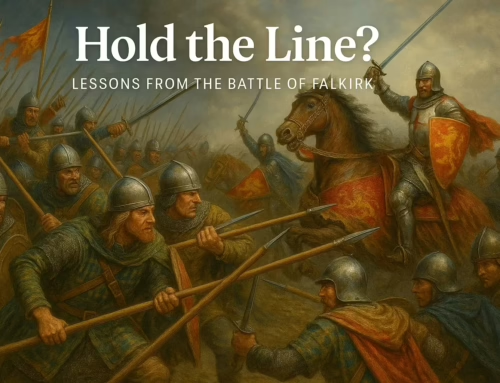It’s the morning of June 18, 1815. The fields south of Waterloo are soaked from days of heavy rain. Artillery wheels sink into the churned earth. Infantrymen—British, Dutch, Prussian, and French—wait, shoulder to shoulder, in tight formation. When the first cannon sounds, it marks the beginning of one of the most famous battles in European history.
And one of the most misunderstood lessons in training and preparedness.
Napoleon’s army outnumbered Wellington’s. His troops were veterans of Austerlitz, Jena, and Wagram. Yet by nightfall, the French line had collapsed. Wellington’s polyglot force—many of them inexperienced—held the ridge, aided by timing, terrain, and the arrival of the Prussians under Blücher.
However, the critical point is that Wellington didn’t win because his troops were better trained individually. He won because they operated within a framework that allowed for real-time adaptation under pressure.
Meanwhile, the French—despite their experience—repeatedly faltered at key moments due to overconfidence, rigidity, and failure to adapt. That failure to change course under pressure is something every modern instructor should recognise.
Let’s look more closely.
The Cavalry Charge That Never Learned
Early in the battle, Marshal Ney misread a temporary British withdrawal and launched one of the most infamous cavalry assaults in military history. For hours, waves of French horsemen charged well-formed Allied squares. But they lacked support. No infantry followed. No artillery softened the line. It was bravery without coordination.
Better tactical training could have changed that outcome. If French junior leaders had been drilled on coordinated arms doctrine—combined fire, massing effect, sequencing—they might have recognised the futility of uncoordinated shock. Instead, they repeated the same assault until their squadrons were shattered.
This is precisely the kind of behaviour modern synthetic training environments are built to prevent. In HAWK, for example, commanders can run multiple iterations of an assault, adjusting force ratios, angles of approach, and sequencing until the optimal method is found—not when it’s too late, but in a controlled training space.
Hougoumont and the Importance of Local Initiative
At the western edge of the battlefield, the château of Hougoumont became a killing ground. A small Allied force held out all day under relentless French pressure. Time and again, the French attacked without proper reconnaissance, without flanking, and without learning from their failed approaches.
Here, training in decision cycles could have saved lives. In today’s terms, the attackers lacked scenario branching and didn’t adapt their tactics to changing conditions—a gap that modern tools like BattleVR are specifically designed to address. We teach operators not just to respond but to think—quickly, under stress, in changing conditions.
The Collapse of the Imperial Guard
In the final phase of the battle, with the Prussians arriving and his flanks weakening, Napoleon sent in his last reserve: the Imperial Guard. Their advance, under fire from British artillery and infantry, broke. When the Guard fell back, the myth of French invincibility died with them.
But it didn’t have to.
Here’s the hard truth: Napoleon’s army wasn’t defeated by firepower alone. It was defeated due to poor communication, poor timing, and a lack of battlefield visibility. The Guard attacked unsupported, unclear on their flank security. There was no common operating picture.
Today, platforms like Hawk exist to solve precisely that problem. With complete simulated battlespace control, commanders can rehearse timing, observe interdependencies, and understand how changes in one area of a scenario ripple across the entire field. It’s what Napoleon lacked—and what modern militaries cannot afford to ignore.
“Waterloo was won on the playing fields of Eton.”
Duke of Wellington
What Waterloo Still Teaches Us
It’s easy to see Waterloo as a tale of heroes, charges, and last stands. But strip away the drama, and it becomes a battle defined by decision-making under uncertainty. Timing. Coordination. Visibility. Flexibility.
It’s not so different from the challenges your teams face today.
So ask yourself: is your training system preparing people to follow a plan—or to improvise when it fails?
Are you giving them a chance to experience pressure, failure, and ambiguity—in a space where they can learn?
Or are we still lining up troops and hoping the squares hold?




